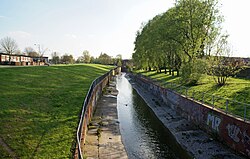River Rea
This article needs additional citations for verification. (January 2018) |
| Rea | |
|---|---|
 The River Rea at Belgrave Middleway (Birmingham) | |
| Etymology | "to flow" (Old English) |
| Location | |
| Country | England |
| Physical characteristics | |
| Source | |
| • location | Waseley Hills Country Park, Worcestershire |
The River Rea (pronounced "ray") is a small river which passes through Birmingham, England. It is the river on which Birmingham was founded by the Beorma tribe in the 7th century.
Name
The name of the Rea derives from a root found in many Indo-European languages and means "to run" or "to flow".
Course
The Rea rises in Waseley Hills Country Park, with the source well signposted from the car park there. The river drops about 70 metres (230 ft) in its first mile, but from then on has a very gentle slope. The river's tributaries include Callow Brook, the Bourne (which begins as Merritts Brook before joining Griffins Brook) and Bourne Brook. From Rubery, the river flows into Birmingham near the former Rover works at Longbridge, then flows through a tunnel under the A38. In Northfield, one of the river's few remaining fords is at The Mill Walk, near Hawkesley Mill Lane. After this, the river valley is also used by the railway to Kings Norton.


Near
Flood prevention measures
The Rea frequently bursts its banks after heavy rain. A £2.7 million scheme to reduce the risk of flooding to homes and businesses in the south of Selly Park was completed in January 2018.[1]
See also
- Rivers of the United Kingdom
References
- ^ "New multi-million pound flood scheme in Birmingham opened - GOV.UK". UK Government. 19 January 2018. Retrieved 20 January 2018.
Further reading
- Stephens, W B, ed. (1964), "Economic and Social History: Mills", A History of the County of Warwick: Volume 7, the City of Birmingham, London: Victoria County History, pp. 253–269
